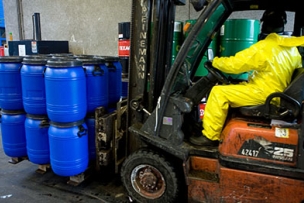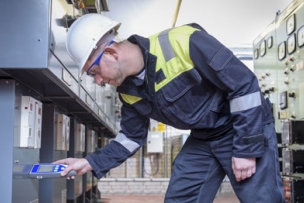Summer Safety: Beat Workplace Heat Stress with Cool Air, Ventilation and HVLS Fans
The warmer months put workers at risk for a variety of heat-related illnesses. Engineering controls such as ventilation and air conditioning can be key to keeping a hot workplace safe.
What You Need To Know
With summer nearly here, companies need to start thinking about ways to keep workers safe from heat-related injuries and illnesses.
Machinery or manufacturing processes can throw off a lot of heat, and workers who need to wear personal protective equipment may feel it even more. Add warmer summer temperatures, and the heat can quickly reach dangerous levels. For indoor facilities, ventilation and HVAC systems play a key role in keeping employees from being overcome by the heat.
According to the Occupational Safety and Health Administration (OSHA), elevated core body temperatures can result in a variety of illnesses. Some, like heat rash and heat cramps, are less serious. But employees who get too hot and are unable to cool down can also end up with heat syncope (lightheadedness and fainting), heat exhaustion, heat stroke or even death. Working in hot environments can also cause injuries as workers cope with issues such as sweaty palms, fogged-up safety goggles and reduced mental functioning, finds the National Institute for Occupational Safety and Health in its report “Criteria for a Recommended Standard: Occupational Exposure to Heat and Hot Environments.”
“There is evidence that heat stress is an increasing problem for many workers, particularly those located in densely populated areas closer to the equator … ” states the report.
The Bureau of Labor Statistics reports that in 2019, exposure to environmental heat led to 43 work-related fatalities.
What are the Effects of Heat Stress in the Workplace?
Exposure to the sun means employees working outdoors are most at risk for heat stress, which, in turn, can increase the likelihood for heat-related deaths and illnesses.
Risk factors for heat-related illness include:
- High temperature and humidity
- Direct sun exposure
- Indoor radiant heat sources
- Limited air movement
- Use of inadequate or incorrect personal protective equipment and clothing
- Physical exertion
Inadequate hydration Individual employees may also be at higher risk if they:
- Are pregnant
- Are of advanced age
- Have previously had heat-related illness
- Have not been acclimated to heat
- Use certain medications
- Are in poor physical condition or have health problems
How to Mitigate Hydration and Heat Stress Problems in the Workplace
OSHA does not have specific guidelines to cover workers at risk of heat stress. However, the General Duty Clause requires employers to keep workplaces free of recognizable hazards. Therefore, if heat is a known hazard, employers have to provide mitigation, say the authors of a report on heat stress in the U.S. construction industry. Mitigation could come in the form of personal protective equipment, cooling stations or air-conditioned spaces, water, first aid, and training, and employers must report any injuries and illnesses related to heat.
Heat exposure and the risk of heat-related illnesses can be reduced with engineering controls and work practices, OSHA notes. Because outdoor workers are most at risk, some workplace practices focus on outdoor-specific methods, like the use of shade and light-colored clothing. However, both indoor and outdoor workers can benefit from methods such as taking breaks in cool or air-conditioned spaces, using cooling personal protective equipment, and drinking plenty of fluids.
HVAC Technology: Using HVLS Fans to Stay Cool Indoors
Engineering controls include methods such as increasing air movement, reducing temperature or humidity, and protecting workers from radiant heat sources. Increasing air movement can be as simple as opening windows. But in some facilities, this isn’t an option.
“Dust, insects and other contaminants can come in with outside air and cause problems with equipment and processes,” writes Kylie Kemper, an account manager for Global Electronic Services. “Other industries need to maintain a specific temperature inside, which requires more precise cooling solutions.”
While smaller floor-mounted fans can help in limited areas, the wind they create can be a problem in some environments. In an article for Industrial Safety & Hygiene News, Andy Olson, a marketing manager at Rite-Hite Corp., says that, in contrast, high-volume, low-speed (HVLS) fans can move large volumes of air over larger areas but provide a gentler breeze.
“A single HVLS fan can replace as many as 20 floor fans, reducing clutter on the ground and lowering the chances of an accident,” Olson says. “By mixing air, HVLS fans also help air-conditioning systems work more efficiently, allowing them to be operated at a lower set point.” HVLS fans create “a 2 to 3 mph breeze that delivers the equivalent of a 7-11 degree decrease in perceived temperature,” writes Dan Linder, a sales manager at Serco Fans, for EHS Today.
Running exhaust ventilation at sites where heat is produced can also help workers stay cool, says OSHA.
And of course it’s crucial to review guidelines from the Centers for Disease Control and Prevention (CDC) on how existing heat illness prevention programs and policies can be tailored to the unique challenges of working during the COVID-19 pandemic.
The Challenges of Cooling the Air in Industrial Settings
In “Criteria for a Recommended Standard,” the authors say evaporative or refrigerative cooling are better options than fans when dry bulb air temperature exceeds 95 degrees F. Spot cooling of individual workers is also an option, the report notes. “However, spot coolers or blowers may interfere with the ventilating systems required to control toxic chemical agents.”
Kemper notes that evaporative coolers, which use a wet cooling pad to chill air through evaporation, work best in dry climates. “In areas where humidity is high, they’re not effective as too much water is already in the air and will make the air more humid,” she writes.
Air conditioning units are popular and effective in some environments, but not always useful for manufacturing facilities, says Kemper. “Air conditioning works well for small areas, but for large areas like factory floors, many or an extremely powerful AC unit would be needed,” she says. “While AC may work for an industrial facility, many use a larger, central cooling system and use portable air conditioners to control heat in areas that get especially hot.”
Whatever method of cooling you choose, make sure managers and employees alike are aware of the signs of heat stress and know how to respond. OSHA offers a variety of resources to help, including a “Quick Card” and information on its website’s heat stress page.
Check out these additional HEAT STRESS Resources & Solutions.
How do you keep workers cool when the temperatures soar? Share your experiences.




Talk to Us!
Leave a reply
Your email address will not be published. Required fields are marked *